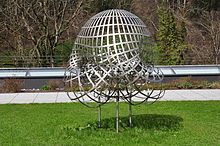Boy's surface

In geometry, Boy's surface is an immersion of the real projective plane in 3-dimensional space found by Werner Boy in 1901. He discovered it on assignment from David Hilbert to prove that the projective plane could not be immersed in 3-space.
Boy's surface was first
Unlike the
Parametrization

Boy's surface can be parametrized in several ways. One parametrization, discovered by Rob Kusner and Robert Bryant,[4] is the following: given a complex number w whose magnitude is less than or equal to one (), let
and then set
we then obtain the
If one performs an inversion of this parametrization centered on the triple point, one obtains a complete
Property of Bryant–Kusner parametrization
If w is replaced by the negative reciprocal of its complex conjugate, then the functions g1, g2, and g3 of w are left unchanged.
By replacing w in terms of its real and imaginary parts w = s + it, and expanding resulting parameterization, one may obtain a parameterization of Boy's surface in terms of
Relation to the real projective plane
Let be the Bryant–Kusner parametrization of Boy's surface. Then
This explains the condition on the parameter: if then However, things are slightly more complicated for In this case, one has This means that, if the point of the Boy's surface is obtained from two parameter values: In other words, the Boy's surface has been parametrized by a disk such that pairs of diametrically opposite points on the
Symmetries

Boy's surface has 3-fold symmetry. This means that it has an axis of discrete rotational symmetry: any 120° turn about this axis will leave the surface looking exactly the same. The Boy's surface can be cut into three mutually congruent pieces.
Applications
Boy's surface can be used in
Model at Oberwolfach

The
Model made for Clifford Stoll
A model was made in glass by glassblower Lucas Clarke, with the cooperation of Adam Savage, for presentation to Clifford Stoll, It was featured on Adam Savage's YouTube channel, Tested. All three appeared in the video discussing it.[5]
References
Citations
- ^ Morin, Bernard (13 November 1978). "Équations du retournement de la sphère" [Equations of the eversion of the sphere] (PDF). Comptes Rendus de l'Académie des Sciences. Série A (in French). 287: 879–882.
- ..
- ISSN 0926-2245.
- ISBN 978-0-8218-1482-6.
- ^ Adam, Savage. "This Object Should've Been Impossible to Make". YouTube. Retrieved 22 June 2023.
Sources
- Kirby, Rob (November 2007), "What is Boy's surface?" (PDF), Notices of the AMS, 54 (10): 1306–1307 This describes a piecewise linear model of Boy's surface.
- Casselman, Bill (November 2007), "Collapsing Boy's Umbrellas" (PDF), Notices of the AMS, 54 (10): 1356 Article on the cover illustration that accompanies the Rob Kirby article.
- Mathematisches Forschungsinstitut Oberwolfach (2011), The Boy surface at Oberwolfach (PDF).
- Sanderson, B. Boy's will be Boy's, (undated, 2006 or earlier).
- Weisstein, Eric W. "Boy's Surface". MathWorld.
External links
- Boy's surface at MathCurve; contains various visualizations, various equations, useful links and references
- A planar unfolding of the Boy's surface – applet from Plus Magazine.
- Boy's surface resources, including the original article, and an embedding of a topologist in the Oberwolfach Boy's surface.
- A LEGO Boy's surface
- A paper model of Boy's surface – pattern and instructions
- A model of Boy's surface in Constructive Solid Geometrytogether with assembling instructions
- Boy's surface visualization video from the Mathematical Institute of the Serbian Academy of the Arts and Sciences
- This Object Should've Been Impossible to Make Adam Savage making a museum stand for a glass model of the surface


![{\displaystyle {\begin{aligned}g_{1}&=-{3 \over 2}\operatorname {Im} \left[{w\left(1-w^{4}\right) \over w^{6}+{\sqrt {5}}w^{3}-1}\right]\\[4pt]g_{2}&=-{3 \over 2}\operatorname {Re} \left[{w\left(1+w^{4}\right) \over w^{6}+{\sqrt {5}}w^{3}-1}\right]\\[4pt]g_{3}&=\operatorname {Im} \left[{1+w^{6} \over w^{6}+{\sqrt {5}}w^{3}-1}\right]-{1 \over 2}\\\end{aligned}}}](https://wikimedia.org/api/rest_v1/media/math/render/svg/24e2d30d1e2883a59c352c8e82321c4d4bca4bff)










